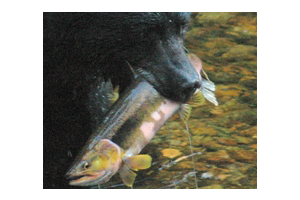Pink salmon is the most abundant salmon in the Pacific Ocean. Its name refers to the color of its flesh, which is more pink than the deep red flesh found in other salmon species.
Photo Credit: Geoffrey A. Hammerson
Oncorhynchus gorbuscha
Common Name: pink salmon
Other Common Names: humpbacked salmon
Animal Guild: Fish
Class > Order > Family: Teleostei > Salmoniformes > Salmonidae
What does the species look like?
Pink salmon have numerous tiny scales and a dorsal fin plus an adipose fin (behind the dorsal fin and in front of tail fin). Their fins do not have spines. They have large, mostly oval black spots on their back and on both lobes of their tail fin. In the ocean, pink salmon have a metallic blue or blue-green upper side, silvery sides, and a white belly.
Spawning males: Spawning males develop a humped back and hooked jaws and have a pink to brown stripe on each side.
Juveniles: Young lack parr marks (dark round patches) that are found on other salmon young.
Adults can reach a total length of around 76 cm.
Where is the species found?
States & Provinces
AK, BC, CA, ON, OR, QC, WA
Distribution
During ocean feeding and maturation, pink salmon range throughout the North Pacific Ocean and Bering Sea north of about 40 degrees north latitude. Populations originating from different coastal regions of the North Pacific occupy distinct ocean nursery areas. The range shifts southward for winter, northward in warmer months.
Spawning occurs in most tributary rivers of northeastern Asia (Korea to Siberia) and in North America from California and Oregon (rare in these states) north to the Aleutian Islands and Mackenzie River delta, Arctic and Pacific drainages. Arctic populations do not appear to be self-sustaining but may be expanding and so warrant monitoring. The species has been introduced in the Great Lakes, Newfoundland, and several European areas.
Pink salmon spawn on gravel bottoms of rivers and tributary streams, sometimes in intertidal reaches. Young fish may be found in inshore waters for several months before they move to sea, where they spend most of their lives.
General Phenology and Life History
With rare exceptions, this species has a two-year life cycle. Adults spend most of their lives (about 18 months) at sea. Prior to spawning, most adults return to their natal stream. Adults move into fresh water sometime between June and September, depending upon latitude. Their migrations upstream are generally less extensive than are those of other Pacific salmon. They usually spawn in mid-July or August to late October. Adults die soon after spawning. Eggs hatch usually from late December to late February, depending on water temperature. After juveniles emerge (generally March-May), they immediately move downstream to estuaries. Young fish may be found in inshore waters for several months before they move to sea. Introduced populations in the Great Lakes are unique in that they complete their life cycle entirely in fresh water.
Special Considerations for Observing
Which phenophases should I observe?
Do you see/hear...?
Activity
Adults in freshwater More...
For abundance, enter the number of individual animals observed in this phenophase.
Adults in saltwater More...
For abundance, enter the number of individual animals observed in this phenophase.
Adults feeding For abundance, enter the number of individual animals observed in this phenophase.
Adults migrating upstream More...
For abundance, enter the number of individual animals observed in this phenophase.
Development
Dead or dying adults For abundance, enter the number of individual animals observed in this phenophase.
Method
Individuals on a hook For abundance, enter the number of individual animals observed in this phenophase.
Individuals in a net For abundance, enter the number of individual animals observed in this phenophase.
What do these phenophases look like?
There is currently no photoguide available for this species. If you'd like help us create one, use the guidance document and species template provided here . Then send it via email to education@usanpn.org when it is complete.
